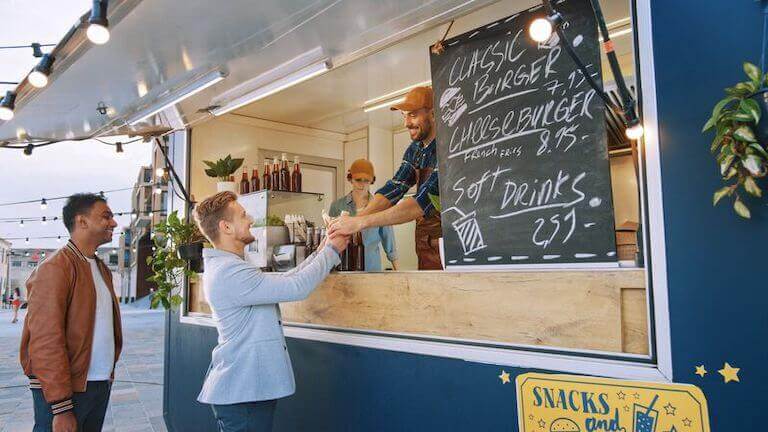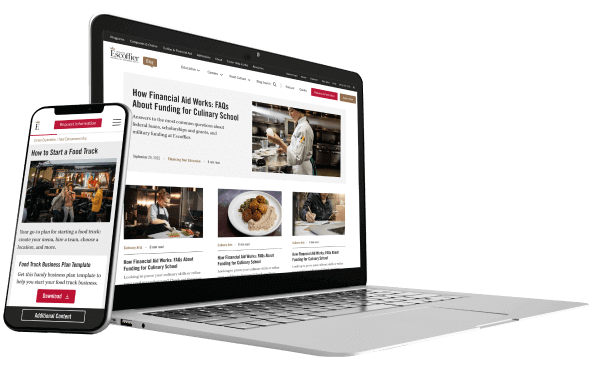Listen to This Article:
As any food truck owner knows, there’s a lot more to running a successful business than churning out delicious food. You also have to keep track of sales and expenses, manage inventory, market to customers, and more.
Fortunately, point of sale (POS) systems can help make these tasks easier. While most food truck owners will tell you a POS system is essential, it can be difficult to determine which one is best for you and your business’s needs.
We’ve rounded up some of the most useful POS systems for food trucks and included helpful details about each. By reading about the differences and considering your business needs, you can select a system that can help you accomplish your food entrepreneurship goals.
*The following prices were taken at the time this article was written, pricing may vary. Please see each provider’s website for current rates.
5 Standout POS Systems for Food Trucks
Point-of-sale (POS) systems typically include monthly fees, processing fees, and hardware fees that vary based on membership level and the features you need. The best POS systems for food trucks are those with reliable hardware, restaurant-specific features, mobile compatibility, and more, at a reasonable price point. Here are five of the most popular food truck POS systems to consider:
1. Square: The User-Friendly POS
Square is a general POS system that includes features such as the ability to process credit cards, track inventory, and create invoices. While it’s not designed for food-based businesses, its $0 fee and well-rounded basic features can make it an attractive choice for new food truck owners or those looking for an inexpensive option. Square offers Restaurant POS apps, mobile POS, kitchen display systems, kiosks, reporting analytics, and more. These features may be offered for an additional fee, though most are included with their premium plan.
Square’s app integrates with both Android and Apple devices, allowing you and your employees to turn any phone into a piece of sales hardware. The company also offers various forms of portable hardware, which means customers can easily order as they’re standing outside your truck.
Square also integrates with third-party delivery platforms including DoorDash and Postmates, so you can offer delivery service. While UberEats and Grubhub don’t have a direct link with Square, Square’s partnership with Chowly allows food truck owners to integrate these orders into their POS system.
Benefits:
- Android and iOS compatibility
- Compact Square terminal can save food truck operators valuable space
- Option to pay for hardware in installment
- Offline functionality
- QR code ordering compatibility
- No long-term contract, cancel any time without termination fees
- Use Square Online to build a website and take orders
- Basic reporting and management tools
- Tipping support
- Restaurant capabilities continue to expand
Cons:
- Some food truck operators may need to use third-party integrations for additional features
- Lack of 24/7 customer support
Expenses:
| Monthly Fee | $0 for Free, $69 for Plus, $165 for Restaurant Premium |
| Processing Fee | 2.6% + $0.10 per in-person transaction 2.9% + $0.30 per online transaction |
| Hardware Costs |
|
2. Toast: The POS for Order Versatility
Toast was designed for restaurants, so it offers numerous features that fit well with food trucks. The basic plan includes the ability to design and share digital menus, run sales reports, and operate simple payment processing.
Toast also offers add-on features including a customer loyalty program, email marketing, and online ordering. You can pick and choose from these features, which means you can meet your business’s needs while only paying for what you’ll use.
If you operate multiple food trucks, Toast is an option worth exploring. It allows you to view sales, inventory, and other details across multiple locations from a single dashboard. That means you can monitor when you need to run supplies from one truck to the next, as well as better determine where to send an employee who is coming in for a shift later that day. Note, however, that Toast POS may require a two-year contract, which could be subject to early termination fees. For those just starting out who don’t yet know how much their food truck might make or what features they’ll need, it may be better to find a POS system that offers month-to-month subscriptions.
Benefits:
- Specifically designed for the restaurant industry
- Hardware is resistant to spills and high-temperature environments, like food trucks
- Order versatility: Accept orders through self-serve kiosks, mobile order and pay services, and Toast’s integrated delivery platform (Toast TakeOut)
- Starter kit includes up to two POS terminals
- 24/7 customer support
Cons:
- Two-year contract required, with fees for early termination
- Lack of full processing fee transparency (quote-based)
- Online transaction fees are higher than some competitors
- Cost of offline mode is not disclosed
- Integrations including online ordering and accounting incur an extra fee
Expenses:
| Monthly Fee | $0 for Starter Kit, $69 for Point of Sale, Build Your Own (custom pricing) |
| Processing Fee | 2.49% + $0.15 for card-present transactions 3.50% + $0.15 for card-not-present transactions (fees range from 3.09%–3.69% + $0.15 per transaction for those who don’t pay for hardware costs upfront) |
| Hardware Costs |
|
*Information may not reflect every student’s experience. Results and outcomes may be based on several factors, such as geographical region or previous experience.
3. TouchBistro: The POS for Data Collection and Marketing
TouchBistro is another POS system designed specifically for food businesses like restaurants and food trucks. As such, it contains thoughtful features that can help address common industry pain points and increase sales. For example, you can easily design menus ahead of time and update them in real-time. That means you and your staff can focus on cooking food during a dinner rush, yet easily stop for a few minutes to remove items that sell out.
When the day is over, you can view sales reports that provide information about which dishes performed best at each location and which items were popular at which times. You can access these reports remotely and also share them with employees via email.
You can also use this data to help create promotions that appeal to core customers. Once you’ve figured out what type of sale or special you’d like to run, you can send them out with TouchBistro’s integrated marketing platform.
TouchBistro operates via an iPad, but you can also add on additional hardware to fit your needs.
Benefits:
- Easy to add integrations and extra features as your food truck grows
- Offline capabilities
- Customers who bank with Chase can access funds within the next business day
- 24/7 customer support
Cons:
- No free plan
- Extra fee to accept online orders
- Requires a contract that automatically renews, with termination fees and/or difficulty cancelling plans
- Lack of full pricing transparency in processing fees and hardware costs (quote-based)
- Customers who don’t have a Chase bank account may see delays between one to four business days before receiving funds, which may present a significant challenge for newer food trucks
| Monthly Fee | $69 for Base Plan, with extra monthly fees for the following features: $25 for gift cards, $50 for online ordering, $99 for marketing or loyalty, $229 for reservation |
| Processing Fee | Offers a variety of fee structures, including flat fee, interchange differential, and flat tiered |
| Hardware Costs | Hardware costs are undisclosed |

The right POS system for your food truck can make ordering and inventory management a breeze.
4. Zettle: The Entry-Level POS
While PayPal has been a household name for years, its POS system Zettle is relatively new. This modern system allows you to take payments, track inventory, and keep an eye on sales. Zettle lacks some features specialty POS systems contain, but its low price point and lack of contract may make up for this.
Zettle’s app makes it easy for an unlimited number of users to ring out customers and track inventory, and also allows you to view sales data no matter your location. If you prefer more specialized hardware, you can purchase a payment processing terminal or stand-alone card reader.
Benefits:
- No long-term contract, cancel any time without cancelation fees
- Use Zettle app to turn a mobile device into a POS system
- Card, PayPal, Venmo, QR codes, and digital wallets accepted
- In-person and QR code processing fees are some of the lowest available
Cons:
- Lacks features beyond basic payment processing
- No offline mode, which may be a dealbreaker for some food truck operators
- Single plan option means you can’t scale features as your food truck grows
- Few integration options
- Phone support only offered 6 a.m. to 6 p.m. PST
Expenses
| Monthly Fee | $0 |
| Processing Fee | 2.29% + $0.09 for in-person and QR code transactions, 3.49% + $0.09 for manual-entry card transactions, 2.99% + $0.49 for invoicing and PayPal payments |
| Hardware Costs |
|
5. Clover: The POS for Customization
Clover’s customer-facing display and sleek menu designs make it simple to create menus that are easy for customers to navigate. Clover also supports menu modifiers such as dressing on the side or extra cheese. That means you can keep track of custom orders, even during a hectic lunch rush.
Although Clover’s monthly fee is more expensive than many other POS systems, it also includes features that some other systems offer as add-ons. No-fee online ordering comes standard, as does tax reporting, promotions, and customer loyalty programs.
Benefits:
- iOS and Android compatibility
- No-fee online ordering included in all restaurant plans
- Secure your own third-party payment processor for better rates than you might get through a payment services provider (like Square)
- Low in-person transaction fees
- Tiered plans for a more customized approach
- 24/7 customer support
Cons:
- Online and keyed-in processing fees can be more expensive than competitors
- If you use Clover as a payment processor you may be subject to early termination fees
- A three-year contract may be required to access promotional pricing
- Some accounting features may incur additional fees
Expenses
| Monthly Fee | $59.95 for Quick-Service Dining Starter or Standard Plan, $79.90 for Quick-Service Dining Advanced plan |
| Processing Fee | 2.3% + $0.10 for in-person transactions with Full-Service and Quick-Service restaurant plans, 3.5% + $0.10 for online or keyed-in transactions Note: these fees may differ if Fiserv is not your merchant service provider |
| Hardware Costs |
|
Choosing a POS System: Things To Consider
The right POS system for one food truck might not be the right choice for another. Here are some things to keep in mind when shopping:
- Monthly, processing, and hardware fees
- Restaurant-specific features, like online ordering, loyalty programs, or delivery service
- Contract length
- Customer service
Narrowing down your exact needs–including the features you don’t need–can make choosing a POS system much easier. You’ll also want to consider all the costs associated with running your food truck to ensure the POS system will work with your finances.
Education: A Crucial Tool
While a POS system can help you manage your food truck’s orders, inventory, and marketing, that doesn’t mean it will complete these processes automatically—you’ll still need the skills and knowledge to oversee all of the aspects of your food truck.
Fortunately, you don’t have to gain this knowledge through trial and error. By studying food entrepreneurship, you can dive into topics such as marketing to your ideal audience, creating a strong brand, and exploring how to determine the profitability of specific dishes.
If you’re interested in taking the first step to becoming a food truck owner or operations manager, contact us to learn more about pursuing a culinary education at Auguste Escoffier School of Culinary Arts.
TO LEARN MORE ABOUT FOOD ENTREPRENEURSHIP, CHECK OUT THESE ARTICLES NEXT:
- The Complete Guide to Starting a Home-Based Catering Business
- How to Start a Restaurant: A Step-By-Step Guide
- How to Start a Food Truck: The Essential Guide
This article was originally published on December 9, 2022, and has since been updated.
*Information may not reflect every student’s experience. Results and outcomes may be based on several factors, such as geographical region or previous experience.


